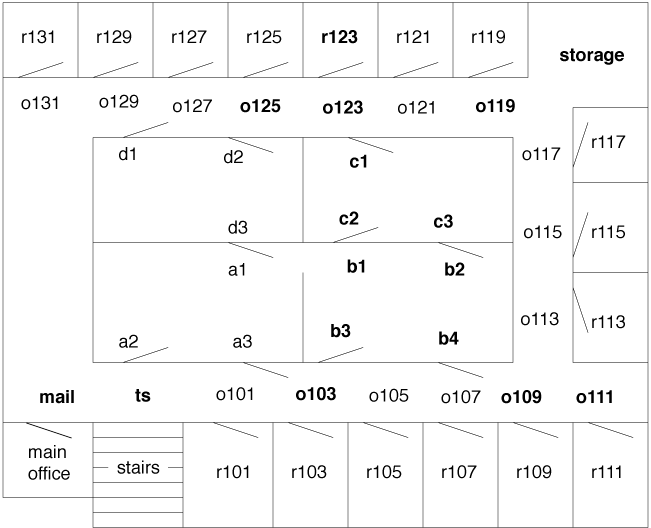Third edition of Artificial Intelligence: foundations of computational agents, Cambridge University Press, 2023 is now available (including the full text).
3.2 State Spaces
One general formulation of intelligent action is in terms of state space. A state contains all of the information necessary to predict the effects of an action and to determine if it is a goal state. State-space searching assumes that
- the agent has perfect knowledge of the state space and can observe what state it is in (i.e., there is full observability);
- the agent has a set of actions that have known deterministic effects;
- some states are goal states, the agent wants to reach one of these goal states, and the agent can recognize a goal state; and
- a solution is a sequence of actions that will get the agent from its current state to a goal state.

An example problem is where the robot is outside room r103, at position o103, and the goal is to get to room r123. A solution is a sequence of actions that will get the robot to room r123.
Notice that this representation has ignored many details, for example, how the robot is carrying the parcels (which may affect whether it can carry other parcels), the battery level of the robot, whether the parcels are fragile or damaged, and the color of the floor. By not having these as part of the state space, we assume that these details are not relevant to the problem at hand.
If the effect of teaching also depends on the aptitude of the student, this detail must be part of the state space, too. We do not have to model what the student is carrying if that does not affect the result of actions or whether the goal is achieved.
A state-space problem consists of
- a set of states;
- a distinguished set of states called the start states;
- a set of actions available to the agent in each state;
- an action function that, given a state and an action, returns a new state;
- a set of goal states, often specified as a Boolean function, goal(s), that is true when s is a goal state; and
- a criterion that specifies the quality of an acceptable solution. For example, any sequence of actions that gets the agent to the goal state may be acceptable, or there may be costs associated with actions and the agent may be required to find a sequence that has minimal total cost. This is called an optimal solution. Alternatively, it may be satisfied with any solution that is within 10% of optimal.
This framework is extended in subsequent chapters to include cases where an agent can exploit the internal features of the states, where the state is not fully observable (e.g., the robot does not know where the parcels are, or the teacher does not know the aptitude of the student), where the actions are stochastic (e.g., the robot may overshoot, or the student perhaps does not learn a topic that is taught), and where complex preferences exist in terms of rewards and punishments, not just goal states.



